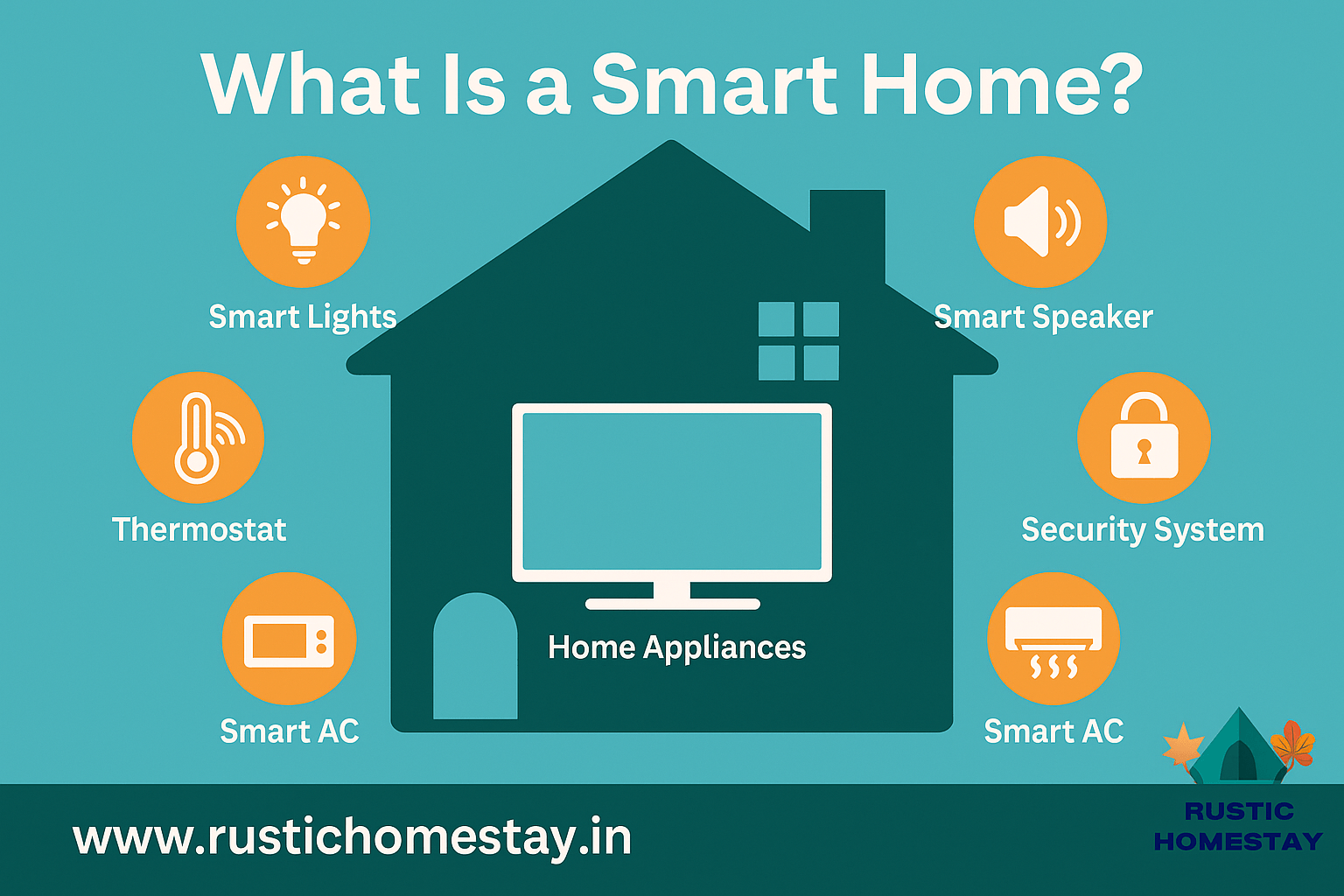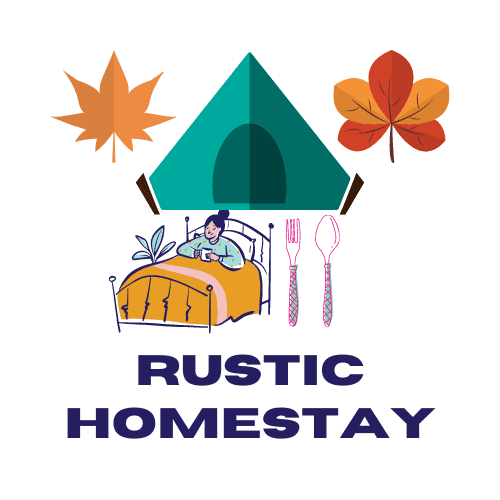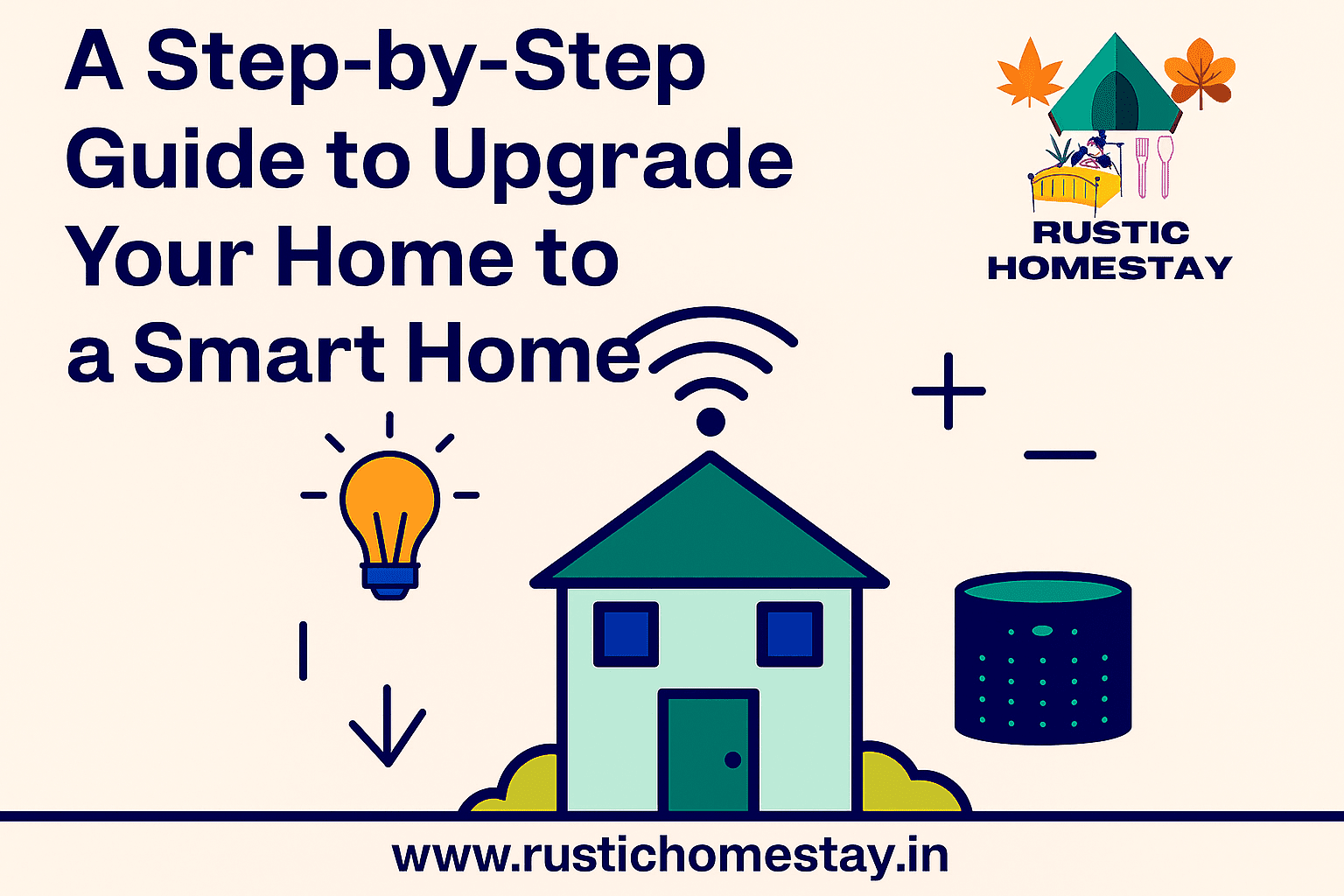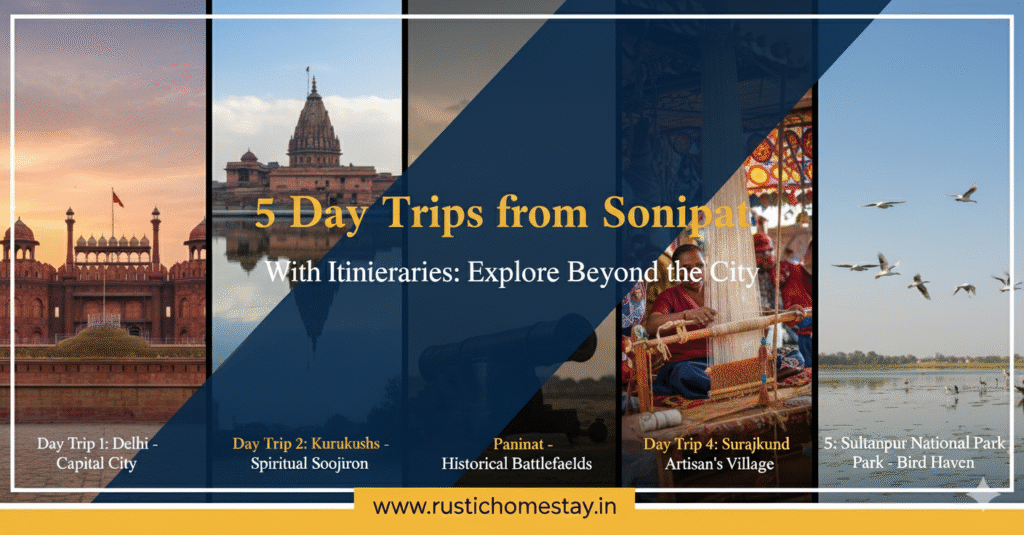Imagine walking into your house and the lights turn on automatically.
Your AC adjusts based on the weather.
Your home knows you better than you know it and operates hands free for the most part.
That’s the promise of a smart home.
But what exactly does it take to make that leap?
And how can you upgrade home to smart home in India?
Wouldn’t it help if there was a plan of action to do it step-by-step, affordably and efficiently?
In this guide, we break it all down—from the basics to advanced integrations.
Plus, we’ll share how Rustic Homestay India is pioneering India’s 1st smart homestay right here in Sonipat, Haryana.
Table of Contents
ToggleWhat is a smart home?

A smart home is a residence equipped with devices that can be controlled remotely via a smartphone, tablet, or voice.
These devices can include:
Smart lights
Thermostats
Security systems
Smart speakers
Home appliances like ACs, washing machines, and TVs
The goal?
To increase efficiency, comfort, and control while reducing manual intervention.
Who should upgrade to a smart home?
Not every home needs to be smart, but here’s who should seriously consider it:
Working professionals who want to automate routine tasks
Solo travelers or frequent flyers looking for enhanced security
Elderly couples seeking comfort and convenience
Families who want centralized control over devices
Rental or homestay hosts aiming to create premium guest experiences
If you’re someone who values time, comfort, and safety, smart is the way to go.
Top considerations before going smart
Before diving into automation, ask yourself:
What’s my budget?
Do I need full-home integration or just certain areas?
Is Wi-Fi strength reliable in all rooms?
Do I prefer voice control (Alexa, Google) or app-based control?
What brands have local support and warranty?
Tip: Start small and expand as needed.
Step-by-Step Guide to Upgrade Your Home
Step 1: Start with a Smart Hub
Choose a platform: Alexa, Google Home, or Apple HomeKit. At Rustic Homestay Sonipat, we chose Alexa.
This becomes your control center- in other words, the brains of the smart home automation.
Step 2: Automate Lighting
Use smart bulbs or switches
- If you have conventional lights pre-installed, there are smart switch modules available in the market, that retro-fit with your existing wiring and pair with your smart hub via Wifi to allow automated control. You can get 2-node, 3-node, 3+1 node or similar configurations depending on what kinds of load you want to control.
Schedule lights or control with voice so you dont have to manually turn them on/off all day every day especially for ambient lights in the exterior.
Step 3: Add Smart Plugs
Convert non-smart appliances (e.g., lamps, coffee machines)
- These plugs allow converting non-smart appliances smart by simply controlling the electricity flow at the source (power socket) itself.
Step 4: Upgrade to a Smart AC
Adjust temperatures automatically based on conditions
Step 5: Enhance Security
Use smart locks, cameras, motion sensors
Step 6: Introduce Smart Entertainment
Smart TVs, speakers, and voice-activated media
Step 7: Monitor with Smart Sensors
Track gas leaks, smoke, motion, and more
Step 8: Set Routines and Scenes
Wake-up scene: lights + coffee + music
Night scene: dim lights + lock doors
- Automate your routines
How Rustic Homestay India is Building India’s 1st Smart Homestay
At Rustic Homestay Sonipat, our first operational site as a part of Rustic Homestay India chain, we’re merging traditional comfort with cutting-edge technology.
Here’s what makes us India’s first smart homestay:
- Contactless check-in/check-out via timed door access codes. No stress to secure keys for accessing the premises or rooms.
- High speed compartmentalized Wi-Fi with separate sub-network for guests and onsite security devices.
- 24×7 closed circuit CCTV cameras to monitor public areas
- Vacuum cleaning robots with preset schedules (adapted to guests’ comfort) to help with hygiene and upkeep of our homestay with no reliance on external manpower.
- IoT device enabled smart ambient lighting in exterior synced via schedule to allow guests to hangout in open spaces even in the dark.
- Fully-automated self-watering garden to help guests stay close to Nature even while living in the City.
- Smart all weather ACs that can be pre-scheduled to turn off at any point in time during day or night.
All this while retaining our warm, rustic design philosophy. Located in Sonipat Haryana, this smart homestay offers an immersive, modern experience to solo travelers, couples, and professionals.
Pros and cons of a smart home
Transforming your home to a smart home requires some thought and like anything else, comes with pros and cons of its own.
Pros
Convenience at your fingertips
Energy-efficient and cost-saving
Enhanced security
Better guest experiences
Cons
Upfront cost
Requires internet connectivity round the clock
Security and privacy concerns if your network and smart devices are not configured properly
Key Takeaways
Upgrading your home to a smart home is no longer a futuristic dream—it’s a practical reality that’s transforming modern living. Whether you’re a solo traveler, a working professional, or someone who simply values convenience and control, the transition can start small and scale gradually as per your needs. It’s essential to understand your lifestyle and set clear priorities before diving into home automation. From smart lighting and climate control to integrated security and voice-activated routines, the possibilities are endless. In the hospitality sector too, smart technology is revolutionizing guest experiences. At Rustic Homestay India, we are proud to introduce India’s first smart homestay in Sonipat Haryana, blending modern automation with the warmth of traditional living. Visit www.rustichomestay.in to explore how a smart homestay can redefine comfort and convenience.



